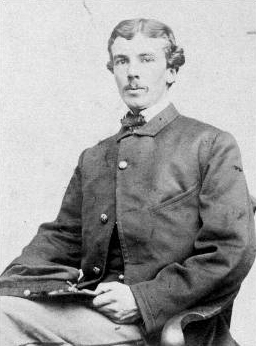Charles Russell Lowell facts for kids
Quick facts for kids
Charles Russell Lowell III
|
|
|---|---|
 |
|
| Born | January 2, 1835 Boston, Massachusetts |
| Died | October 20, 1864 (aged 29) Middletown, Virginia |
| Place of burial |
Mount Auburn Cemetery, Cambridge, Massachusetts
|
| Allegiance | United States Union |
| Service/ |
United States Army Union Army |
| Years of service | 1861 — 1864 |
| Rank | |
| Commands held | 2nd Massachusetts Cavalry |
| Battles/wars | |
| Spouse(s) | Josephine Shaw (m. 1863–1864; his death) |
| Children | Carlotta Russell Lowell |
| Relations |
|
Charles Russell Lowell III (born January 2, 1835 – died October 20, 1864) was a brave general in the Union Army during the American Civil War. He was also a successful businessman before the war. He was badly hurt in the Battle of Cedar Creek and sadly passed away. Many important generals admired him greatly.
Contents
Early Life and Education
Charles Russell Lowell III was born in Boston, Massachusetts. His family was well-known. His mother, Anna Cabot Jackson, wrote books and poems. His uncles included famous writers like James Russell Lowell.
Charles was a very smart student. He graduated at the top of his class from Harvard College in 1854. After college, he worked in an iron mill and for a railroad company. He even spent two years traveling abroad. Before the war, he managed an iron factory in Cumberland, Maryland.
Joining the Civil War
When the Civil War began, Lowell joined the Union Army in June 1861. He started as a captain in the 3rd U.S. Cavalry. Soon after, he moved to the 6th U.S. Cavalry.
He worked closely with General George B. McClellan. He was an aide, helping the general plan and organize the Army of the Potomac. He stayed with General McClellan during important battles like the Peninsula Campaign and the Battle of Antietam in 1862.
Leading the Cavalry
In 1863, Lowell helped create and train a new group of soldiers: the 2nd Massachusetts Cavalry. He became their colonel on May 10.
During the winter of 1863–1864, he was in charge of protecting Washington, D.C., the nation's capital. He helped stop a surprise attack by Confederate General Jubal Early that almost reached the city.
In 1864, Lowell led a group of cavalry soldiers under General Philip Sheridan. He showed great courage and skill in the Valley campaigns of 1864.
Key Battles and Bravery
Lowell was a hero in several battles:
- He fought bravely at the Third Battle of Winchester.
- He played a big part in defeating the Confederates at the Battle of Tom's Brook.
His Final Battle
On October 19, 1864, during the Battle of Cedar Creek, Lowell was seriously wounded. He was leading a counterattack when he was hit. General Sheridan quickly made sure he was promoted to brigadier general that very day.
Sadly, Charles Russell Lowell III died the next day, October 20, 1864, in Middletown, Virginia. He was only 29 years old. He is buried at the Mount Auburn Cemetery in Cambridge, Massachusetts.
Even after his death, his promotion was made official. This was a special exception allowed by the Secretary of War, Edwin M. Stanton. Generals like George Armstrong Custer and Sheridan were very sad to hear of his passing. Sheridan said Lowell was "the perfection of a man and a soldier."
Family Life
In October 1863, Lowell married Josephine Shaw. She was the sister of his good friend, Colonel Robert Gould Shaw, who also died in the war.
Josephine was a very active and caring person. She became interested in helping people with social problems in New York City. She was the first woman to be appointed to the New York State Board of Charities. She also started a charity organization and wrote books about helping others.
Charles and Josephine had one daughter, Carlotta Russell Lowell, who was born on November 30, 1864, after her father had passed away.
Legacy
The first book about Charles Russell Lowell III was written in 1907 by Edward Waldo Emerson. He was the son of the famous writer Ralph Waldo Emerson.



